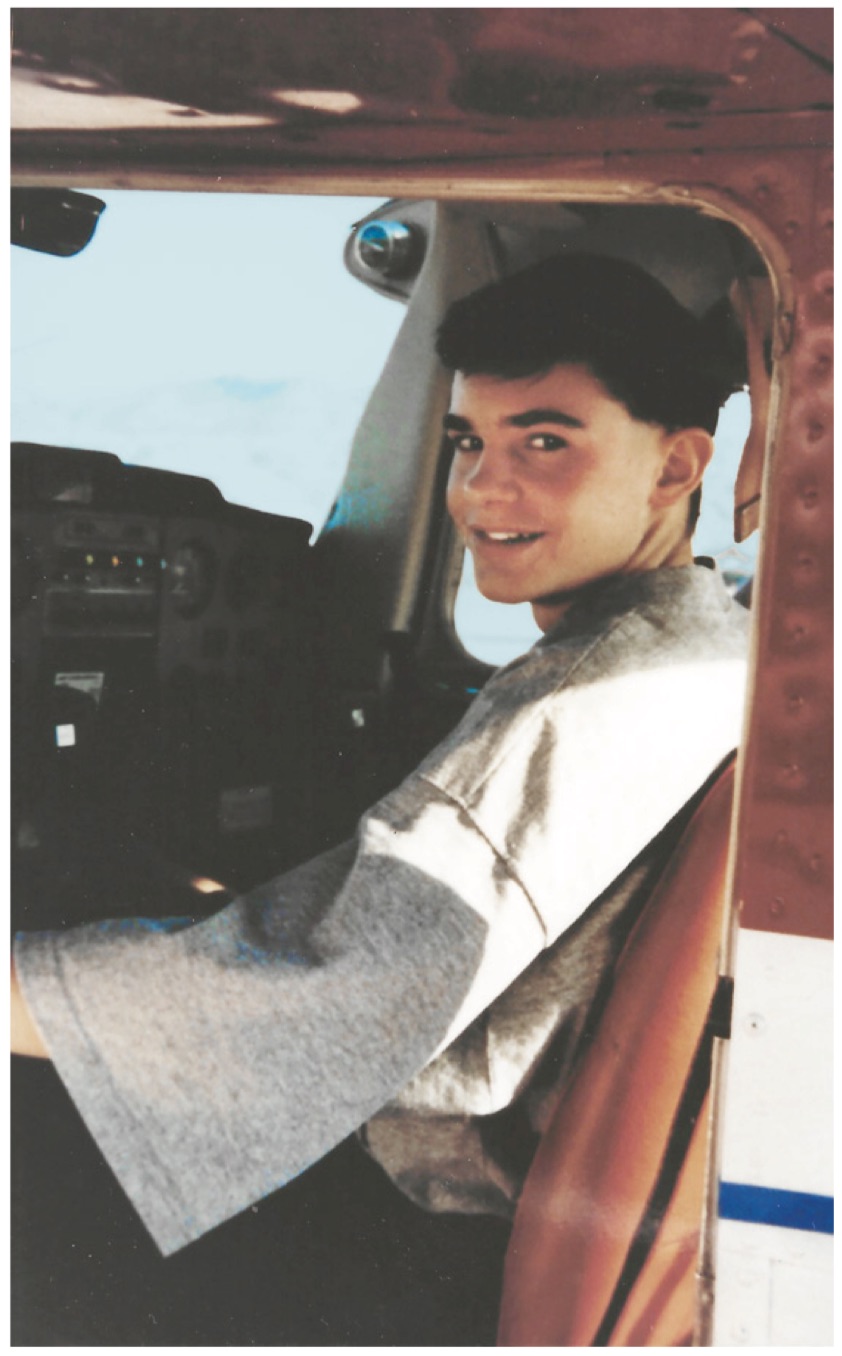30,000-Foot View
Growing up, Chris Anderson’s favorite thing to do was park at the end of a runway and watch planes take off and land with his dad. “I grew up in a family who didn’t have a lot of resources, so they had to get creative when entertaining us kids,” Anderson says. “I used to dream about what it would be like to be one of the passengers or—better yet—one of the pilots.”
Soon, he was reading any book he could find about aviation. “I got my first job as a teenager to support flying lessons. I ended up soloing on my 16th birthday,” Anderson says. “For as long as I could remember, aviation has been my muse.” But there came a time when he had to take a break.
He says, “I was a young father and ultimately, a businessperson responsible for building a company. There was a key man insurance policy that kept me from flying for about 10 years. Back in 2016, I was CEO of another company that sold to Energizer, the battery company.
“When the transaction closed, I did two things immediately. The first was taking a big breath because it represented the end of a marathon that had been at a sprinter’s pace for the better part of 15 years; and, next, I put down a deposit on a plane.”
Since then, Anderson has piloted a variety of planes. “From a Cirrus SR22 Turbo to a Piper M600. They all have their specific purposes. The Cirrus is more of a short- to the intermediate-range airplane. It’s just a pleasure to fly. It’s the one I’d take on a Saturday afternoon with my son, who is also a pilot, and have some fun flying to the different airports around the region. But when I’m traveling across the country, the Piper M600 is a jet-fueled plane that can cruise to nearly airliner altitudes, and really cover some ground.”
Whenever he can get a chance, Anderson is in the air. Once a month, he visits HPG’s creative center facility in Danville, California from his home base in Salt Lake City. “When I do, I fly myself,” he says. “It’s an absolute joy of a flight. En route, I have some of the most beautiful, if not surreal sights outside of my windows –everything from abandoned solar generators in the middle of the Nevada desert (that look like something out of science fiction), to a birds-eye view of Half Dome.
 “I fly over the barren west desert of Utah and desert of Nevada. Then, it turns into the Sierra Nevada and eventually, I’m over Yosemite. It’s truly breathtaking the contrast of the topography I’m flying over. Then, I meet up with the incredibly talented and passionate team here in NorCal, and it fuels me.”
“I fly over the barren west desert of Utah and desert of Nevada. Then, it turns into the Sierra Nevada and eventually, I’m over Yosemite. It’s truly breathtaking the contrast of the topography I’m flying over. Then, I meet up with the incredibly talented and passionate team here in NorCal, and it fuels me.”
Anderson says his insatiable appetite for new information and new experiences is what initially fed his passion for flying. This appetite continues to rev his engine. “It enables me to relate to more people,” he says. “That, to me, is the goal of my life—to add as much value as I possibly can, and uplift as many people as possible along the way. Ultimately, I want those relationships to lead both of us to places that we otherwise wouldn’t have arrived.”
Especially now, Anderson says the successful must have an insatiable appetite for new information. “They are not too worried about what made them successful yesterday. They’re worried about what’s changed in the meantime and what it is that’s going to be necessary in terms of adjustments or new strategies and tactics to ensure success in today’s mission,” he says. “It’s not all that dissimilar from an important lesson every pilot learns at some point in her or his flying: Just because the forecast said the weather was going to be clear and sunny, you need to be ready to adapt to unexpected changes in your environment at any time.The best pilots—or businesspeople—are those who see the world around them for it is, rather than what they wish it to be.
Anderson joined the promo industry in 2002 with supplier HandStands, became president of the company in 2009 and CEO in 2010. Under his leadership, HandStands expanded its distribution into 138 countries and closed multiple strategic acquisitions, including the eventual sale of the HandStands promotional business to HPG in 2018. In 2019, Anderson became CEO of HPG.
Today, he oversees nine facilities with over 1,000 employees in multiple countries. He says his growth over the years has been an exercise in persistence. Anderson says, “I pride myself on not being afraid to fail. At any point in my career or with the businesses I’ve been affiliated with, we’ve either been winning or we were learning. That willingness to invest and either learn or win, has really marked the inflection points of my career.”
But collaborating with talented teams is the real highlight. Anderson says, “My career has been nothing more than a series of very fortuitous relationships. I have worked and continue to work with a collection of incredibly talented and passionate individuals. For example, I’m nowhere near as good at corporate finance as Kim Hayes, our CFO. I’m nowhere near the product developer as Aaron Irvin, our head of product development. The list goes on.

“But what I’ve become over time is someone who is reasonably conversant in each language of business, and can help facilitate effective dialogue between the various functions. I’ve found that to be a very effective catalyst for getting things done quickly.
In the cockpit, just like in business, task saturation is a hurdle. To focus, Anderson trusts his instruments. “If you start to go off hunch, that’s when things go bad real quick,” he says. “I remember the first time I was tasked with flying an airplane with sole reference to instruments and no reference to the outside environment. You are wearing a mask over your eyes to where you can only see the instruments.
“Within a few moments, what your gut tells you is up, you’re actually going down. When your gut tells you you’re straight and level, you’re actually in a steep bank. It’s quite a powerful analogy.”
Anderson says it’s the same for running a business: Trust your instruments. “The instruments—or sources of valuable information—that I have in front of me are not only the data; but, more critically, the talented team and leaders surrounding me,” he says.
Trusting your team is paramount. “I am going to take a signal from this proven, reliable and accurate source, and I am going to use that to steer my broader strategy. Then, I am going to move on to the next ‘indicator.’ Just like running a high-functioning cockpit, you have to have good sources of information, trust in those sources and empower them to steer the overall ship instead of a single pilot operating on gut feeling hunch.”
Anderson began his four-year term on the PPAI Board immediately after The PPAI Expo 2022 in January. He says, “There’s a reason why PPAI has functioned as a very successful nonprofit industry association for as long as it has, and it comes down to the caliber and motivations of the people who comprise it and help to lead it.”
For Anderson, one of those individuals is PPAI President and CEO Dale Denham. “Dale recognizes the value-added potential of a precisely executed technology strategy,” Anderson says. “That was refreshing and frankly, encouraging to me. It was a factor in my excitement and willingness to participate in the PPAI Board and help to, hopefully, steer it in the direction of growth and sustainability.”
When it comes to corporate social responsibility and sustainability, Anderson says the industry has been a strong advocate. “But I look at sustainability as more of a global phenomenon. If you have a business that’s environmentally sustainable, but not economically or technologically sustainable, it’s a not-for-long proposition,” he says.
To be a viable industry, Anderson says promo must be sustainable from a CSR, economic and technological standpoint. He says, “As I look at our industry, it’s really those three primary deliverables that we, as a collective supplier and distributor base, are going to have to have an obsessive-like focus about over the next five to 10 years.”
This “three-legged stool” is crucial. Anderson says, “It will position this $25 billion-plus industry for continued growth and relevance. Are we good stewards in terms of being citizens in the communities we serve? Are we a sustainable business model in terms of value added at each step and culminating in a delighted end user?”
This ‘delighted end user’ should always be the main focus. Anderson says, “The only security that we have in this enterprise is a delighted end user. Everything else is irrelevant unless the end user who receives your product is delighted by the experience. It’s my job, if nothing else, to obsess about what it is to have a delighted end user.”
Figuring out how to delight end users is something Anderson will continue to do as he serves on the PPAI Board. “My desire to serve was largely informed by what I saw around me—smart, capable committed people who had the long-term mindset that a high promo tide will raise all boats.”

